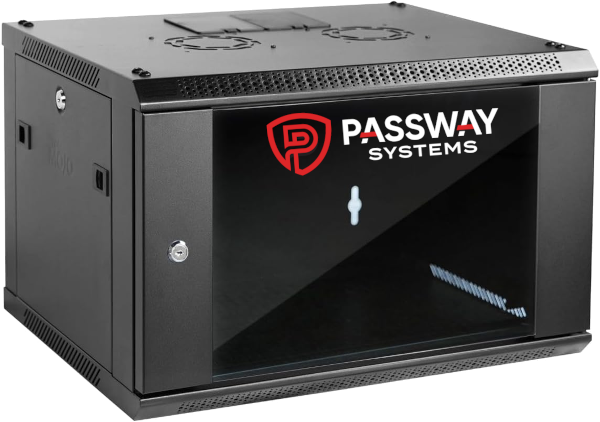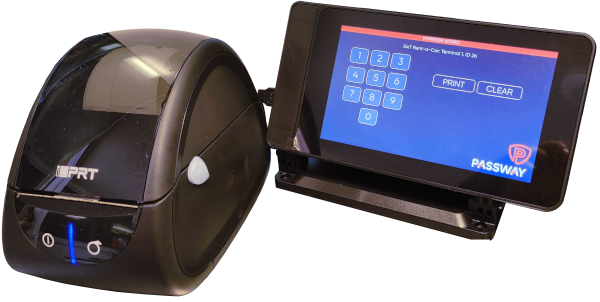Passway Access Control System
The Passway Access Control System is an automated exit system that provides security during the exit process, and eliminates the need for a costly security guard at the exit gate.
Which Solution is Right for Me?
The system consists of three primary components:
Server / Firewall / Network
The Server, Firewall, and additional Network devices provide the logic, storage, management, and support functions of the system. They’re installed in a climate-controlled environment along with the remainder of your back-office components. One Server and Firewall are required per installation.

Barcode Terminal
The Barcode Terminal is a touch-screen and label printer that generates the barcodes, which are given to the customers to allow them to trigger the exit.

Exit Scanner
The Exit Scanner is pole-mounted and attached near the exit so that it’s accessible by the driver approaching the exit.
The Exit Scanner accepts multiple forms of authorization, such as:
- Barcodes: These labels are provided to customers to initiate the exit, and the most common use-case. A barcode is printed on the Barcode Terminal and provided to the customer. The customer is scans the barcode at the Exit Scanner to open the gate. Barcodes are one-time-use and have a customizable expiration time.
- RFID Card: These are typically given to employees that need to trigger the exit on a regular basis. Most commonly, these are employees transporting vehicles from the QTA back to the customer lot. RFID cards can also be custom-printed to function as Company ID Cards.
- Intercom: The intercom is push-button activated, and allows the driver to speak with a person, who can then optionally open the gate for the driver by pressing a button on the phone.
- Remote Control: The remote controls are attached to keychains, and are most often used by shuttle drivers to trigger the gate to open upon approach.
- Keypad: A keypad can be mounted onto the Exit Scanner so that a predetermined code can be entered to trigger the gate.
- Custom Barcode: A custom barcode (such as one that you might already have printed on a rental agreement) can be scanned into the system and enabled as an exit authorization.

Optional Features
In addition to the core components, there are several optional components.
- License Plate Recognition (LPR): A camera is mounted at the rear of the vehicle and takes a photo when the Exit Scanner is activated. The system stores the recognized license plate, and can optionally use it for additional authorization.
- Driver Camera: A camera can be mounted in the Exit Scanner, which is triggered when the Exit Scanner is activated, to take a photo of the driver’s face.
- Other Cameras: Any number of high-resolution cameras can be posted around the vehicle to take photos of the vehicle from different angles, which can be used for multiple reporting purposes, including to verify the vehicle’s condition immediately before leaving the lot.
- API: We offer an Application Programming Interface that allows you configure your car rental software to interact directly with the system. For instance, instead of using the Barcode Terminal to print a barcode that you had to the customer, you can configure your rental car software to print a barcode on the rental agreement, then send that barcode to the system via the API to enable it as an exit authorization.
Management
The Passway Access Control System is managed through a web interface. The interface is used for setting up user accounts, RFID cards, generating reports, and setting configuration options.
Installation
Before installation, the site needs to be prepared. The Passway Access Control System operates on its own network. This can either be a physically separate network (i.e. cabling installed specifically for the system), a VLAN, or a combination of the two, depending on your existing infrastructure and environment.
Here are the specific requirements:
- The Server, Firewall, and Back-End hardware need to be connected to power and in an indoor and safe environment, and connected to the Passway Access Control System network.
- The Barcode Terminals need to be connected to the Passway Access Control System network. They can be outdoor, but need to be protected from rain or other harsh weather conditions.
- The Exit Scanner needs to be connected to the Passway Access Control System network. They need to be located on the driver’s side of the vehicle when the vehicle is stopped at the exit gate, generally 12-15 feet back from the gate. They can function in a parking garage or open parking lot.
Power is only required for the Server, Firewall, and Back-End hardware. All other devices are powered by Power-over-Ethernet (PoE).
FAQs
What kind of gates and barriers does the Passway Access Control System work with?
We’ve installed our system with different models of gates and barriers from a variety of manufacturers, including Spike Systems, DoorKing, Delta Scientific, and many others. Generally, it’ll work with any gate or barrier that accepts an external control signal.
Does Passway Systems install the Passway Access Control System, or do I install it myself?
We customize and manage each installation. We’ll work with your local contractors to provide details about any infrastructure requirements (like cabling) that might be needed for our system. Then we’ll travel to your location and provide installation, configuration, and training for your staff.
What are the power requirements?
Very low. Each installation is different, but all of the equipment is low power, and can easily run on battery backup in the event of a power outage.
What do I need to do to be ready for the Passway Access Control System installation?
The system uses its own network. This can be a physically isolated network, a VLAN on an existing network, or some combination of the two. Which method you choose will depend onyour existing infrastructure and your environment. But we’ll guide you through the entire preparation.

